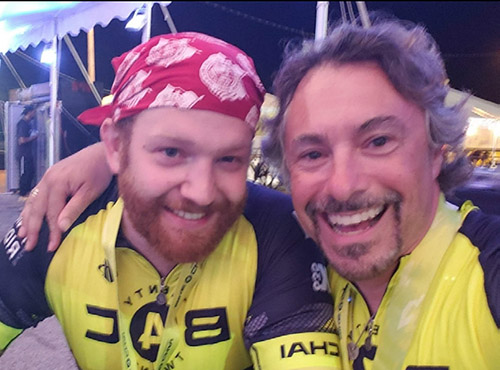


After eight hours and over 70 miles of cycling, we were nearing the end of Bike4Chai 2020. We had battled heat, humidity and never-ending inclines.
With fewer than eight miles to go, I noticed that my gears were not responding. My first thought was, “The battery that powers my shifters is dying. I’m going to have to get in the support van and leave my athletes.”
I have always preached that “failure is not an option.”
What to do?
My thoughts drifted to the Apollo 13 story. When Jim Lovell said, “Houston, we’ve had a problem. We’ve had a main B bus undervolt,” he was describing a dying spacecraft, a quarter of million miles from home. One of the solutions was to recharge the life support batteries from the moonlander’s batteries.
I started thinking of ways I could do that from on top of my bicycle. True that I didn’t have a multimillion dollar spacecraft, but I also wasn’t alone in the vacuum of space either.
We, the Knight Riders Team, had a three quarter ton pickup truck as our support vehicle. I could probably, hopefully, recharge the bike’s internal battery from a spare cell phone battery in the truck, while I continued to ride.
Except the shifters were not completely dead. I could shift the chain between the different sized back cogs, but I was stuck in the small ring in the front.
Most triathlon bikes have a big and small ring of “teeth” that the chain feeds into. It is pure physics: You push the pedal down, the “teeth” pull the bike chain around the drivetrain. If you gotta get stuck, it is better to be in the small ring. The small ring is for climbing hills and we had many of those left to ride. It is the equivalent of your car not being able to go faster than 10 miles an hour, but you can make it home driving slowly.
Once I figured out that dilemma, a new problem decided to arrive.
Riding behind JJ takes precision. I was mere inches from his back wheel. A split second loss of focus could have resulted in my crashing into J and ending our ride possibly even causing serious illness or injury to both of us.
The last four miles of the ride I asked him how he was doing. I actually didn’t need to ask—the pain it was written all over his face.
“How ya doing J?”
“I’m hurting.”
“Where?”
“Everywhere.”
“Well, that’s good. At least it is bilateral.”
In “coach speak,” if a specific area hurts it could be any number of problems, but if the pain is on both sides, it is most likely fatigue. I estimated that we had 30 minutes of riding left.
To help keep him motivated I wanted to start counting down the miles. The only problem was we were in near darkness. If I looked down at my Garmin bike computer and JJ suddenly slowed up my front wheel would have collided with the back of his bike and we would have looked like a twisted metal modern art exhibit. I asked Scott and Tuli for updates so I could avoid both JJ and the potholes that pockmarked the darkened road. This was working…until the last two miles.
I couldn’t look over at JJ, but I could tell that the fatigue was getting worse. His pace was slowing down.
“J we are less than two miles from the finish. I want you to focus on the sooner we finish the sooner you will see your wife and kids.”
I hoped that was enough to keep JJ moving. Anything was better than calling it a day and climbing into the truck.
The event bills itself as the world’s greatest finish line. That is because in a normal year we ride into the camp itself and are greeted by the campers we have been fundraising for.
This year was only one day and we had already seen the kids at the lunch rest stop. When we rolled into this year’s finish line there were people cheering and there was festive music. There was confetti.
We had made it.
When we finally stepped away from our bikes I embraced J and told him, “This year was harder than it should have been. I am beyond proud of what you have done.”
It was 9:09 in a parking lot illuminated by floodlights. We sat down to a steak dinner and I looked over. A praying mantis had crawled up on my arm. I had been so worried about my athletes, that I hadn’t stopped to notice everything else around me. So, I Googled “Praying Mantis” to see what I could take away from this moment.
This bug is symbolic of stillness and calm.
After 11 hours of cycling and all the challenges the day brought us, this bug’s message resonated just fine with me.
David Roher is a USAT certified marathon and triathlon coach. He is a multi-Ironman finisher and a veteran special education teacher. He can be reached at: [email protected]�Instagram @Davidroher140.6










